Flying Aircraft Carriers of the USAF
|
![]()
 In the early years of the cold war,
the United States Air Force was faced with a requirement for an
airplane that could photograph targets deep inside the Soviet
Union. Many strategic targets were inaccessible to conventional
U. S. reconnaissance airplanes. There was no airplane with
sufficient range to reach these targets that also possessed the
speed and maneuverability to evade Soviet air defenses.
In the early years of the cold war,
the United States Air Force was faced with a requirement for an
airplane that could photograph targets deep inside the Soviet
Union. Many strategic targets were inaccessible to conventional
U. S. reconnaissance airplanes. There was no airplane with
sufficient range to reach these targets that also possessed the
speed and maneuverability to evade Soviet air defenses.
It was envisioned that Fighter Conveyer (FICON) composite aircraft would perform long-range reconnaissance missions into areas equipped with anti-aircraft defenses that existing reconnaissance airplanes could not penetrate. FICON operations would rely on the great range of the Convair RB-36 to carry a jet powered parasite airplane to a location within range of targets inside defended territory. The high speed and maneuverability of the parasite would allow it to dash into enemy territory to take pictures of the targets and then rendezvous with its flying aircraft carrier to be carried back to its home base. Many targets that were out of range of conventional reconnaissance airplanes would be accessible to the FICON parasite airplane.
In the years following World War II, the Air Force modified many heavy bombers to serve as reconnaissance airplanes. Boeing B-29 Superfortresses were converted to serve as photographic reconnaissance platforms. The reconnaissance versions of the Superfortress were given the designation F-13. They had great endurance and could carry large format cameras. These reconnaissance bombers flew long missions along the perimeter of Soviet Bloc countries. They took long-range oblique photographs into the interior of the target countries using extremely long focal-length telephoto lenses. The detailed images were recorded on film that was 18 inches wide. They also used the electronic reconnaissance gear to ferret out sources of radio, radar, and telemetry signals within the target countries.
The giant Convair B-36 was used extensively for reconnaissance in the early post-war period. They were built in two major versions, the standard B-36 bomber variant and the RB-36 version tailored for aerial reconnaissance. The B-36 bomber was equipped with four bomb bays. The RB-36 version had an additional pressurized compartment for camera gear in place of the forward bomb bay of the B-36 bomber.
In the early years of its deployment, the RB-36 was very difficult to intercept. It could cruise at altitudes that jet fighters could not reach. If a fighter did succeed in climbing to the altitude of the RB-36, the lower wing loading of the RB-36 allowed it to turn tighter than the fighter could. The RB-36 could simply turn out of the way of a fighter as it mushed along at a speed only slightly higher than its stall speed.
The maneuvering advantage of the RB-36s did not last long. The Soviet Union was quickly developing more capable interceptors with superior high altitude performance. It was clear that jet fighters with the ability to intercept the RB-36 would be entering service in the Soviet Air Force by the middle of the 1950s. It would become too dangerous to operate the RB-36 on reconnaissance missions near the borders of the Soviet Union.
By June 1954, the Air Force changed the primary mission of the four Strategic Reconnaissance (Heavy) Wings that were equipped with RB-36s from reconnaissance to bombing. The RB-36s were longer be used for the mission of strategic reconnaissance. They were modified to carry nuclear weapons as strategic bombers.
A new aircraft was needed for the strategic reconnaissance role. The new aircraft needed the long range of the RB-36 and the speed and maneuverability of a jet fighter. Many thought that it would not be possible to accomplish the projected mission with a conventional airplane. It was proposed that strategic reconnaissance missions could be performed by tactical jet fighters that were launched from RB-36s near the borders of the target countries.
In 1950, in anticipation of the eventual retirement of the RB-36 fleet from the reconnaissance role, the Air Force initiated a program to equip RB-36s with a mechanism to carry a smaller reconnaissance airplane. The smaller airplane would have the speed and maneuverability to penetrate enemy air defenses in the place of the RB-36. The RB-36 would transport the parasite to the enemy zone, where it would be released to perform its own reconnaissance mission. After completing its mission, the parasite would rendezvous with the RB-36 to be retrieved and carried back to its home base.
Initial tests were conducted with a modified Convair RB-36F 49-2707 and straight wing Republic F-84E Thunderjet 49-2115 at the Convair factory in Fort Worth, Texas.
 The FICON test team pose with EF-84E 49-2115 (Bud Anderson):
The FICON test team pose with EF-84E 49-2115 (Bud Anderson):
Left to right:
B. A. Hohman - Wright Field, Project Officer
Levine - Convair, B-36 Pilot
Coughlan - Wright Field, F-84 Crew Chief
T/Sgt. G. I. Davis - Convair, B-36 Pilot
Capt. J. S. McCollom - Wright Field, Project
Maj. C. E. Anderson - Wright Field, F-84 Pilot
Unknown - Convair, B-36 crew member
E. D. Mathis - Convair, Project Engineer
Roberts - Convair, Flight Test EngineerCapt. R. D. Hodge - Wright Field, Project
Major Pinkerton - Wright Field, Photo Pilot
Shedorski - Republic
Unknown
 The original trapeze mechanism on the GRB-36F at Fort Worth in early 1952. Th probe of the EF-84E fits into the cone shoped receiver on the front end of hte trapeze. Latches on either side of the yoke engage pins on the Thunderjet. (Still frame from Reconnaissance Parasite Aircraft)
The original trapeze mechanism on the GRB-36F at Fort Worth in early 1952. Th probe of the EF-84E fits into the cone shoped receiver on the front end of hte trapeze. Latches on either side of the yoke engage pins on the Thunderjet. (Still frame from Reconnaissance Parasite Aircraft)
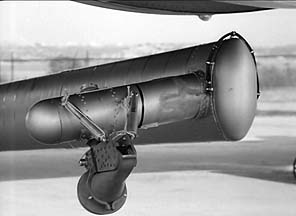 The trapeze receiver. (Still frame from US Air Force film 19661 Reconnaissance Parasite Aircraft)
The trapeze receiver. (Still frame from US Air Force film 19661 Reconnaissance Parasite Aircraft)
The hook of the McDonnell XF-85 Gobiln had been mounted directly above the center of gravity of the diminutive jet. Movement of the Goblin on the trapeze was restricted by a retractable "horse collar" mechanism that closed around its nose. The FICON probe was mounted well forward of the center of gravity of the parasite. Under tow, the weight of the parasite was supported by its wings until the fuselage pins seated in the aft latches of the trapeze.
 A special dolly was rigged for ground loading the Thunderjet. The YB-60 jet bomber prototype can be seen behind the EF-84E. (Still frame from Reconnaissance Parasite Aircraft)
A special dolly was rigged for ground loading the Thunderjet. The YB-60 jet bomber prototype can be seen behind the EF-84E. (Still frame from Reconnaissance Parasite Aircraft)
 Major Clarence "Bud" Anderson made the first attempt to hook F-84E 49-2115 to the GRB-36F 49-2707 over Texas on January 9, 1952. A B-29 Superfortress was flying chase off their left wing. The long boom was too flexible. The Thunderjet pitched up and down, so Anderson immediately released from the trapeze. The problem persisted on the second attempt to hook up when the failure of the probe release mechanism forced Anderson to jettison the probe with explosive squibs. (US Air Force Photo 46206AC via National Archive)
Major Clarence "Bud" Anderson made the first attempt to hook F-84E 49-2115 to the GRB-36F 49-2707 over Texas on January 9, 1952. A B-29 Superfortress was flying chase off their left wing. The long boom was too flexible. The Thunderjet pitched up and down, so Anderson immediately released from the trapeze. The problem persisted on the second attempt to hook up when the failure of the probe release mechanism forced Anderson to jettison the probe with explosive squibs. (US Air Force Photo 46206AC via National Archive)
Bud Anderson is a WWII Triple Ace who flew the P-51 Mustang, "Old Crow" while assigned to the 357th Fighter Group "Yoxford Boys", 8th Air Force, Leiston Field, United Kingdom. Visit the Clarence E. "Bud" Anderson web site. I highly recommend buying and reading a copy of his book, To Fly and Fight. It contains his first person accounts of the early FICON test flights.
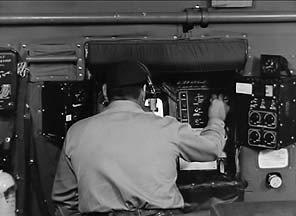 The trapeze operator's station in the camera compartment of the GRB-36F. A window in the bulkhead provided a view of the Thunderjet on the trapeze in the bomb bay. (Still frame from Reconnaissance Parasite Aircraft)
The trapeze operator's station in the camera compartment of the GRB-36F. A window in the bulkhead provided a view of the Thunderjet on the trapeze in the bomb bay. (Still frame from Reconnaissance Parasite Aircraft)
![]() Trapeze Operator's Station illustration from Utility Flight Handbook USAF Series GRB-36D-III/RF-84F Featherweight Configuration III Composite Aircraft; T.O. 1B-36(R)(G)D-1/T.O. 1F-84(R)(G)F-1; July 30, 1954, revised June 17, 1955. (Roger Cripliver)
Trapeze Operator's Station illustration from Utility Flight Handbook USAF Series GRB-36D-III/RF-84F Featherweight Configuration III Composite Aircraft; T.O. 1B-36(R)(G)D-1/T.O. 1F-84(R)(G)F-1; July 30, 1954, revised June 17, 1955. (Roger Cripliver)
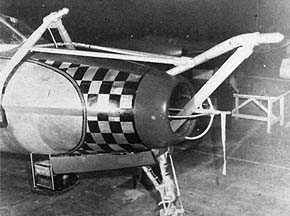 The trapeze boom was shortened to reduce its flexibility. A second probe was installed on the nose of the Thunderjet. (Bud Anderson)
The trapeze boom was shortened to reduce its flexibility. A second probe was installed on the nose of the Thunderjet. (Bud Anderson)
 A shock absorbing snubber was installed between the front end of the tapeze and the front of the bomb bay. It prevented the boom from wiggling, but it allwed it to be slowly raised and lowered. (Still frame from Reconnaissance Parasite Aircraft)
A shock absorbing snubber was installed between the front end of the tapeze and the front of the bomb bay. It prevented the boom from wiggling, but it allwed it to be slowly raised and lowered. (Still frame from Reconnaissance Parasite Aircraft)
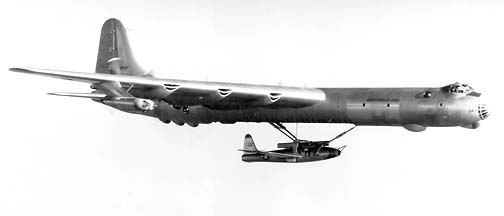 After the Thunderjet engaged the receiver (one-point position), a hydraulic cylinder raisesd the front of the trapeze until the pins on the sides of the EF-84E seated in the aft latches (three-point position). The Thunderjet pilot could push on the stick to lift the tail and force the pins into the latches. (Don Pyeatt)
After the Thunderjet engaged the receiver (one-point position), a hydraulic cylinder raisesd the front of the trapeze until the pins on the sides of the EF-84E seated in the aft latches (three-point position). The Thunderjet pilot could push on the stick to lift the tail and force the pins into the latches. (Don Pyeatt)
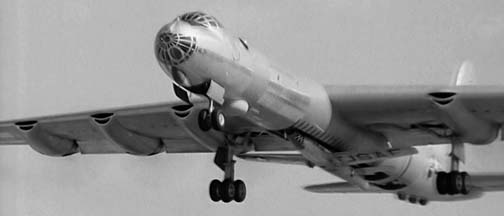 Taking off with the parasite on the trapeze was no problem, but the landing gear could not be retracted until the trapeze was extended to get the wings of the Thunderjet out of the way. Cycling the trapeze and retracting the gear took nearly ten minutes. (Still frame from Reconnaissance Parasite Aircraft)
Taking off with the parasite on the trapeze was no problem, but the landing gear could not be retracted until the trapeze was extended to get the wings of the Thunderjet out of the way. Cycling the trapeze and retracting the gear took nearly ten minutes. (Still frame from Reconnaissance Parasite Aircraft)
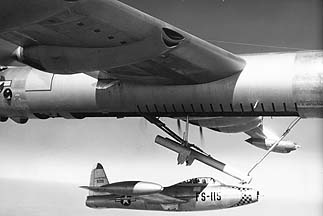 FICON flight tests moved to the Air Proving Ground at Eglin AFB, Florida in the second half of 1952. A cleaner probe was installed farther forward on the nose of the EF-84E, and the trapeze boom was lengthened. (Bud Anderson)
FICON flight tests moved to the Air Proving Ground at Eglin AFB, Florida in the second half of 1952. A cleaner probe was installed farther forward on the nose of the EF-84E, and the trapeze boom was lengthened. (Bud Anderson)
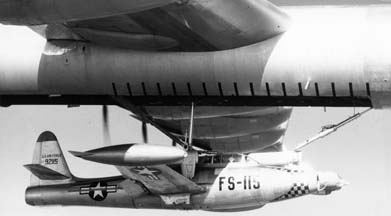 More pilots were introduced to the system at Eglin. Penetration missions were flown to evaluate the effectiveness of the composite aircraft system against the Air Defense Network. The parasite consistently manged to fly over the target airfields without being intercepted. (Bud Anderson)
More pilots were introduced to the system at Eglin. Penetration missions were flown to evaluate the effectiveness of the composite aircraft system against the Air Defense Network. The parasite consistently manged to fly over the target airfields without being intercepted. (Bud Anderson)
![]() The YRF-84F had served as the prototype of the swept-wing F-84F Thunderstreak. It was modified from a straight wing F-84E. The "drooped" horizontal stabilizer was angled downward to clear the sides of the bomb bay. The pin protruding from the side of the fuselage engaged the aft latch of the trapeze. (Republic photo #26-1632 via Fairchild Hiller)
The YRF-84F had served as the prototype of the swept-wing F-84F Thunderstreak. It was modified from a straight wing F-84E. The "drooped" horizontal stabilizer was angled downward to clear the sides of the bomb bay. The pin protruding from the side of the fuselage engaged the aft latch of the trapeze. (Republic photo #26-1632 via Fairchild Hiller)
![]() A new fork-type "duck-bill" probe was installed on the nose of the YRF-84F. In conjunction with a v-shaped receiver on the trapeze, it significantly increased the capture area. The name Christine has been crossed out and the name George added, which appears to be a gender modification reference. Straight wing - female, swept wing - male? (Republic photo #26-1632 via Fairchild Hiller)
A new fork-type "duck-bill" probe was installed on the nose of the YRF-84F. In conjunction with a v-shaped receiver on the trapeze, it significantly increased the capture area. The name Christine has been crossed out and the name George added, which appears to be a gender modification reference. Straight wing - female, swept wing - male? (Republic photo #26-1632 via Fairchild Hiller)
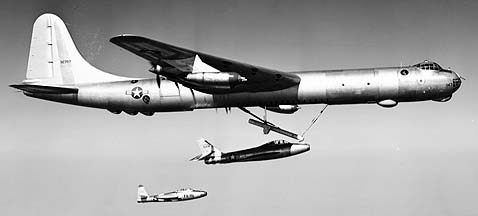 EF-84E 49-2115 continued to serve Project FICON as a chase plane after the introduction of YRF-84F 49-2430. (Convair photo 26-1643 via Lockheed-Martin Tactical Aircraft Systems)
EF-84E 49-2115 continued to serve Project FICON as a chase plane after the introduction of YRF-84F 49-2430. (Convair photo 26-1643 via Lockheed-Martin Tactical Aircraft Systems)
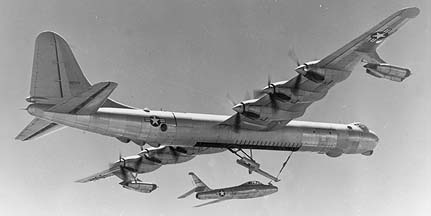 Lt. Colonel Bud Anderson was drafted back into Project FICON when Major John Davis was killed in the Project Tip-Tow crash on April 24, 1953. Anderson performed the initial evaluation of the YRF-84F parasite in May 1953. He then familiarized Major Clyde Good with the methods of FICON and handed off the evaluation to him. (US Air Force photo 47481ac via National Archive)
Lt. Colonel Bud Anderson was drafted back into Project FICON when Major John Davis was killed in the Project Tip-Tow crash on April 24, 1953. Anderson performed the initial evaluation of the YRF-84F parasite in May 1953. He then familiarized Major Clyde Good with the methods of FICON and handed off the evaluation to him. (US Air Force photo 47481ac via National Archive)
![]() (Republic photo 35421 via Fairchild Hiller)
(Republic photo 35421 via Fairchild Hiller)
 The trapeze raises the Thunderstreak to the three-point position. Note the v-shaped receiver on the trapeze. Wright Air Development Center badges have been applied to the fuselage of the YRF-84F. (Clyde Good)
The trapeze raises the Thunderstreak to the three-point position. Note the v-shaped receiver on the trapeze. Wright Air Development Center badges have been applied to the fuselage of the YRF-84F. (Clyde Good)
 Major Good found that he could influence the flight path of the GRB-36F using the controls of YRF-84F while it was attached to the extended trapeze. (Natinoal Museum of the US Air Force)
Major Good found that he could influence the flight path of the GRB-36F using the controls of YRF-84F while it was attached to the extended trapeze. (Natinoal Museum of the US Air Force)
 Major Good completed his initial evaluation of the YRF-84F parasite on July 23, 1953. (Bud Anderson)
Major Good completed his initial evaluation of the YRF-84F parasite on July 23, 1953. (Bud Anderson)
![]() The FICON composite aircraft system was demonstrated at the National Air Show at Dayton, Ohio in 1953 and 1954. The FICON system was also demonstrated at airshows at Carswell Air Force Base, Texas and Eglin Air Force Base, Florida. The GRB-36F, piloted by Raymond Fitzgerald, took off from Fort Worth and flew to Dayton, where Major Good took off in the YRF-84F and hooked onto the trapeze for transportation to the show. The Thunderstreak was released from the trapeze at show center. (San Diego Aerospace Museum)
The FICON composite aircraft system was demonstrated at the National Air Show at Dayton, Ohio in 1953 and 1954. The FICON system was also demonstrated at airshows at Carswell Air Force Base, Texas and Eglin Air Force Base, Florida. The GRB-36F, piloted by Raymond Fitzgerald, took off from Fort Worth and flew to Dayton, where Major Good took off in the YRF-84F and hooked onto the trapeze for transportation to the show. The Thunderstreak was released from the trapeze at show center. (San Diego Aerospace Museum)
 Major Clyde Good working his way from the cockpit of the YRF-84F to the camera compartment. The final FICON evaluation flight of the YRF-84F was flown on June 9, 1954. (Clyde Good)
Major Clyde Good working his way from the cockpit of the YRF-84F to the camera compartment. The final FICON evaluation flight of the YRF-84F was flown on June 9, 1954. (Clyde Good)
![]() Convair conducted ground loading and other FICON system evaluations with GRB-36D 49-2696 and pre-production prototype FICON RF-84F Thunderflash 51-1847 starting in December 1954. (Convair
photo 26-1916 via LMTAS)
Convair conducted ground loading and other FICON system evaluations with GRB-36D 49-2696 and pre-production prototype FICON RF-84F Thunderflash 51-1847 starting in December 1954. (Convair
photo 26-1916 via LMTAS)
![]() The GRB-36D had clearance doors that streamlined the bomb bay while the parasite was on board and plug doors to fill the hole left by its release. (Convair photo 26-1906 via LMTAS)
The GRB-36D had clearance doors that streamlined the bomb bay while the parasite was on board and plug doors to fill the hole left by its release. (Convair photo 26-1906 via LMTAS)
Load tests of the main jack mechanism of the trapeze revealed that it required strengthening. High speed tests of the modified FICON RF-84F resulted in flutter that damaged its rear fuselage. The project was delayed as the issues were dealt with and project aircraft were reassigned to accomplish the necessary tests.
![]() GRB-36D 49-2701 flying over Grand Coulee Dam in Washington. Ten GRB-36Ds were modified. They could be distinguishced by the AN/APX-29 rendezvous beacon antenna radome on top of the fuselage. Active duty GRB-36Ds were assigned to the 348th Bombe Squadron of the 99th Strategic Bomber (Heavy) Wing at Fairchild Air Force Base, Wshington.
GRB-36D 49-2701 flying over Grand Coulee Dam in Washington. Ten GRB-36Ds were modified. They could be distinguishced by the AN/APX-29 rendezvous beacon antenna radome on top of the fuselage. Active duty GRB-36Ds were assigned to the 348th Bombe Squadron of the 99th Strategic Bomber (Heavy) Wing at Fairchild Air Force Base, Wshington.
![]() The 91st Strategic Reconnaissance Squadron of the 71st Strategic Reconnaissance (Fighter) Wing at Larson Air Force Base operated the FICON RBF-84F Thunderflashes. The RBF-84F designation indicated that the fighters had been modified for bombing and reconnaissance. From front to rear these are 52-7268, 52-7266, 52-7269, 52-7260, and 52-7262. (Republic photo16975 via Fairchild Hiller)
The 91st Strategic Reconnaissance Squadron of the 71st Strategic Reconnaissance (Fighter) Wing at Larson Air Force Base operated the FICON RBF-84F Thunderflashes. The RBF-84F designation indicated that the fighters had been modified for bombing and reconnaissance. From front to rear these are 52-7268, 52-7266, 52-7269, 52-7260, and 52-7262. (Republic photo16975 via Fairchild Hiller)
![]() FICON training operations began in December 1955. (Dave Menard via John Graff)
FICON training operations began in December 1955. (Dave Menard via John Graff)
 FICON RBF-84F 52-7269 is lowered from the bomb bay of GRB-36D 49-2696 at Fairchild AFB, Washington following an emergency night retrieval on December 12, 1955. The parasite pilot suffered a partial hydraulic system failure but succeeded in hooking onto the trapeze. Post-flight inspection revealed that he had turned off his own hydraulic system due to the distractions of approaching the trapeze.(NMUSAF)
FICON RBF-84F 52-7269 is lowered from the bomb bay of GRB-36D 49-2696 at Fairchild AFB, Washington following an emergency night retrieval on December 12, 1955. The parasite pilot suffered a partial hydraulic system failure but succeeded in hooking onto the trapeze. Post-flight inspection revealed that he had turned off his own hydraulic system due to the distractions of approaching the trapeze.(NMUSAF)
![]() FICON training operations were halted after several pilots from the 91st Strategic Reconnaissance Squadron damaged their airplanes trying to hook on to the trapeze during exercises on Friday January 13, 1956. Less than one month later, Thunderflashes from the 91st SRS took on fuel from a Boeing KC-97 Stratotanker in flight for the first time. The Boeing RB-52B reconnaissance Stratofortress, Lockheed U-2, and aerial refueling superceded the composite aircraft system before it reached operational status. (NMUSAF)
FICON training operations were halted after several pilots from the 91st Strategic Reconnaissance Squadron damaged their airplanes trying to hook on to the trapeze during exercises on Friday January 13, 1956. Less than one month later, Thunderflashes from the 91st SRS took on fuel from a Boeing KC-97 Stratotanker in flight for the first time. The Boeing RB-52B reconnaissance Stratofortress, Lockheed U-2, and aerial refueling superceded the composite aircraft system before it reached operational status. (NMUSAF)
The Air Force conducted evaluations of the FICON composite aircraft system at the Air Proving Ground at Eglin AFB, Florida, the Air Force Special Weapons Center at Kirtland AFB, New Mexico, and the Air Force Flight Test Center at Edwards AFB, California in 1955 and 1956.
The designation of the FICON RF-84F/RBF-84F was changed to RF-84K in early 1956.
 GRB-36D 49-2694 and RF-84K 52-7258 were assigned to Phase IV Limited Performance Evaluations at Edwards AFB. (US Air Force Photo A-162244AC via National Archive)
GRB-36D 49-2694 and RF-84K 52-7258 were assigned to Phase IV Limited Performance Evaluations at Edwards AFB. (US Air Force Photo A-162244AC via National Archive)
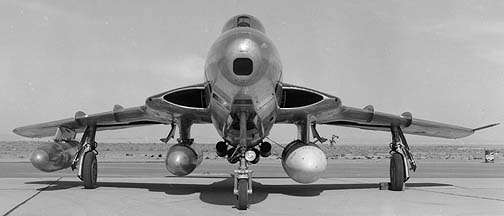 RF-84K 52-7258 at Edwards Air Force Base with a pair of external fuel tanks on its right wing and a T-63 "special weapon" test shape on its left wing. In order to take off with the heavy load, it is equipped with four 1,000-pound thrust solid fuel rockets, mounted between the external fuel tank and the simulated atomic bomb. (US Air Force photo e-161916ac via National Archive)
RF-84K 52-7258 at Edwards Air Force Base with a pair of external fuel tanks on its right wing and a T-63 "special weapon" test shape on its left wing. In order to take off with the heavy load, it is equipped with four 1,000-pound thrust solid fuel rockets, mounted between the external fuel tank and the simulated atomic bomb. (US Air Force photo e-161916ac via National Archive)
 The RF-84K Phase IV Limited Performance Evaluation was conducted by future X-2 pilot Captain Milburn "Mel" Apt. He hooked on to the trapeze on one occasion on March 23, 1956. The RF-84K carried no external stores during the hook on. It took eleven tries for Apt to hook on. (US Air Force Photo B-161916AC via National Archive)
The RF-84K Phase IV Limited Performance Evaluation was conducted by future X-2 pilot Captain Milburn "Mel" Apt. He hooked on to the trapeze on one occasion on March 23, 1956. The RF-84K carried no external stores during the hook on. It took eleven tries for Apt to hook on. (US Air Force Photo B-161916AC via National Archive)
 GRB-36D 49-2694 made seven flights during the Phase IV Limited Performance Evaluation between November 29, 1955 and April 27, 1956. The RF-84K hooked on during the fifth flight. External stores were mounted on the RF-84K for the last two flights. (US Air Force photo 162223ac via National Archive)
GRB-36D 49-2694 made seven flights during the Phase IV Limited Performance Evaluation between November 29, 1955 and April 27, 1956. The RF-84K hooked on during the fifth flight. External stores were mounted on the RF-84K for the last two flights. (US Air Force photo 162223ac via National Archive)
The FICON Flight Handbook, Illustrated Parts Breakdown, and Maintenance Handbook defined the modifications and operational procedures of the composite aircraft system.
![]() The General Arrangement Diagram from Utility Flight Handbook. (Roger Cripliver)
The General Arrangement Diagram from Utility Flight Handbook. (Roger Cripliver)
![]() Cutaway view of the GRB-36D from the Standard Aircraft Characteristics document for the Consolidated GRB-36D and the Republic RF-84F. (NMUSAF)
Cutaway view of the GRB-36D from the Standard Aircraft Characteristics document for the Consolidated GRB-36D and the Republic RF-84F. (NMUSAF)
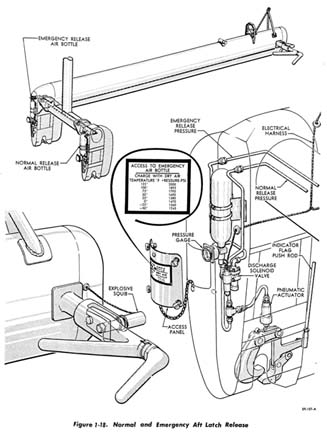 Normal and Emergency Aft Latch Release Diagram from Supplemental Handbook - Maintenance Instructions GRB-36D-III (NMUSAF)
Normal and Emergency Aft Latch Release Diagram from Supplemental Handbook - Maintenance Instructions GRB-36D-III (NMUSAF)
![]() Trapeze Operation Diagram from the GRB-36D/RF-84K
Limited Phase IV Flight Evaluation document. (Air Force Flight Test Center History Office)
Trapeze Operation Diagram from the GRB-36D/RF-84K
Limited Phase IV Flight Evaluation document. (Air Force Flight Test Center History Office)
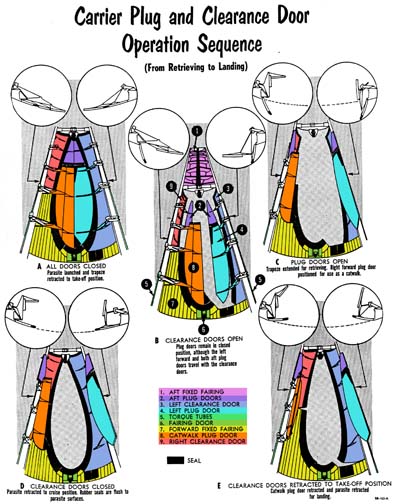 Carrier Plug and Clearance Door Operation Sequence Diagram from GRB-36D Maintenance Handbook. (US Air Force Museum)
Carrier Plug and Clearance Door Operation Sequence Diagram from GRB-36D Maintenance Handbook. (US Air Force Museum)
![]() Trapeze Hydraulic System Schematic from Utility Flight Handbook. (Roger Cripliver)
Trapeze Hydraulic System Schematic from Utility Flight Handbook. (Roger Cripliver)
![]() V-Probe Installation Diagram from RF-84F-17-RE Group Assembly Parts List. (NMUSAF)
V-Probe Installation Diagram from RF-84F-17-RE Group Assembly Parts List. (NMUSAF)
Republic RF-84F/K ThunderflashWingspan: 34 feetLength: 48 feetWing Area: 325 square feetMaximum Take-off Weight: 27,000 poundsArmament: 4x 50 caliber machine gunsPowerplant: 7,800 pound s.t. J65 turbojet |
The complex and dangerous FICON composite aircraft system was overtaken by the development of the Boeing B-52 Stratofortress, the Lockheed U-2, and aerial refueling using the flying boom method. The FICON Thunderflashes were transferred to the Air National Guard. The GRB-36D carriers were scrapped in short order.
Several of the FICON parasite airplanes are preserved in museums.
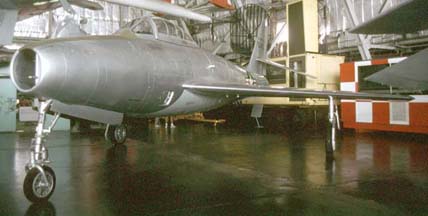 Today the YRF-84F, 49-2430 resides
in the National Museum of the Air Force. (Brian Lockett)
Today the YRF-84F, 49-2430 resides
in the National Museum of the Air Force. (Brian Lockett)
![]() The pre-production RF-84K, 51-1847
was scrapped by the National Museum of the Air Force due to severe corrosion after years of display outdoors at the Citadel. It appears in the episode of the TV show Columbo titled By Dawn's Early Light, which was filmed at the Citadel. (Greg Spahr)
The pre-production RF-84K, 51-1847
was scrapped by the National Museum of the Air Force due to severe corrosion after years of display outdoors at the Citadel. It appears in the episode of the TV show Columbo titled By Dawn's Early Light, which was filmed at the Citadel. (Greg Spahr)
Link to the National Museum of the Air Force
![]() RF-84K, 52-7259 was displayed at the Yankee
Air Museum, Ypsilanti, MI. It has been transferred to the National Museum of the Air Force since this
photograph was taken. (Greg Spahr)
RF-84K, 52-7259 was displayed at the Yankee
Air Museum, Ypsilanti, MI. It has been transferred to the National Museum of the Air Force since this
photograph was taken. (Greg Spahr)
Link to the Yankee Air Museum
![]() RF-84K, 52-7259 has been restored and is now on display at the National Museum of the Air Force. (Greg Spahr)
RF-84K, 52-7259 has been restored and is now on display at the National Museum of the Air Force. (Greg Spahr)
![]() RF-84K, 52-7259 at the National Museum of the Air Force. (Greg Spahr)
RF-84K, 52-7259 at the National Museum of the Air Force. (Greg Spahr)
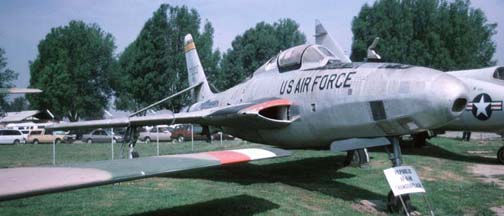 RF-84K, 52-7265 at the Planes of
Fame Museum at Chino, CA on March 15, 1997. (Brian Lockett)
RF-84K, 52-7265 at the Planes of
Fame Museum at Chino, CA on March 15, 1997. (Brian Lockett)
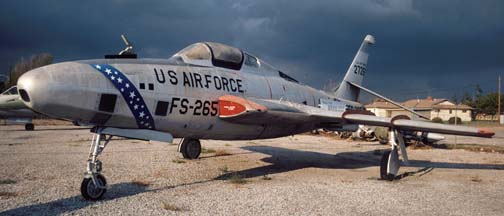 RF-84K, 52-7265 at the Planes of
Fame Museum on October 28, 2000. (Brian Lockett)
RF-84K, 52-7265 at the Planes of
Fame Museum on October 28, 2000. (Brian Lockett)
Link to the Planes of Fame Museum
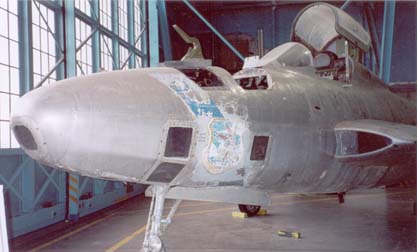 RF-84K, 52-7266 is currently
undergoing restoration at the Wings Over the Rockies Museum,
Denver, Colorado. (John Graff, Wings Over
the Rockies Museum)
RF-84K, 52-7266 is currently
undergoing restoration at the Wings Over the Rockies Museum,
Denver, Colorado. (John Graff, Wings Over
the Rockies Museum)
Link to the Wings Over the Rockies Museum

![]() I prepared an illustrated review of Hobbycraft's 1/144-scale model of the FICON composite aircraft system.
I prepared an illustrated review of Hobbycraft's 1/144-scale model of the FICON composite aircraft system.
 Flying Aircraft Carriers of the USAF
Flying Aircraft Carriers of the USAF
eBook editions of Flying Aircraft Carriers of the USAF |
||
|
My books in the Flying Aircraft Carriers of the USAF series are now available as eBooks, at a considerably reduced price compared to the print editions. Following World War II, the US Air Force was faced with the need to extend the range of fighter escorts for bomber airplanes. Several programs explored the feasibility of carrying, launching, and retrieving jet fighters from Convair B-36 bombers. In 1948 and 1949, the Air Force tested the McDonnell XF-85 Goblin, which was intended to fit inside the bomb bay of the B-36, in a series of launches from a modified Boeing B-29 Superfortress. From 1949 to 1956, the Air Force explored wing tip coupling, attaching smaller airplanes to the wing tips of larger airplanes, first with a Culver PQ-14 coupled to a Douglas C-47 Skytrain, then with a pair of Republic F-84E Thunderjets coupled to a Boeing B-29 Superfortress, and concluding with tests of Republic RF-84F Thunderflashes coupled to the wing tip of a Convair B-36. From 1952 to 1956, Project FICON (Fighter Conveyer) evaluated carrying Republic F-84s partially enclosed in the bomb bay of a B-36, concluding with the establishment of squadrons of modified Republic RF-84F Thunderflashes and Convair B-36s in Washington State. Each volume is profusely illustrated with vintage photographs and diagrams. They can be dowloaded directly from Lulu.com. |
||
|
Flying Aircraft Carriers of the USAF: McDonnell XF-85 Goblin
|
Flying Aircraft Carriers of the USAF: Wing Tip Coupling
|
|
LockettBooks Bookshelf |
|||
BooksMy books are printed on demand by Lulu.com. When you select one, it is placed in your Lulu.com shopping cart. When you place your order, the items are produced, packaged, and shipped directly to you. Books are 8.5" x 11" with perfect binding, white interior paper (60# weight), white exterior paper (100# weight), and full-color exterior ink. |
|||
|
Flying Aircraft Carriers of the USAF: Project FICON Preview the first several pages of the paperback book. Flying Aircraft Carriers of the USAF: Project FICON |
Flying Aircraft Carriers of the USAF: Wing Tip Coupling |
||
|
Project FICON Handbooks |
|||
You can buy a 2020 calendar featuring historic Air Force and Convair photographs of Project FICON Convair GRB-36 carrier aircraft and Republic F-84 parasites.
A dozen Air Force and Convair photographs of Project FICON Convair GRB-36 carrier aircraft and Republic F-84 parasites from 1952 to 1956:
Convair GRB-36F 49-2707 and Republic F-84E Thunderjet 49-2115 at Forth Worth, Texas and Eglin Air Force Base, Florida
Convair GRB-36F 49-2707 and Republic YRF-84F Thunderstreak 49-2430 at Fort Worth, Texas and Dayton, Ohio
Convair GRB-36D 49-2962 and Republic RBF-84F Thunderflash 52-7266 over Washington State
Convair GRB-36D 49-2694 and Republic RF-84K Thunderflash 52-7258 at Edwards Air Force Base, California
 Put a copy of the Project FICON - Fighter Conveyer: 2020 calendar in your Lulu.com shopping cart for $14.95.
Put a copy of the Project FICON - Fighter Conveyer: 2020 calendar in your Lulu.com shopping cart for $14.95.
Books about Project FICON
| |||||
Go to the home page of the Goleta Air
and Space Museum. 
Send a message to Brian.